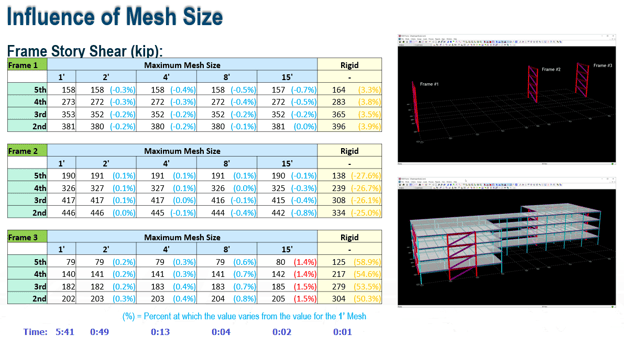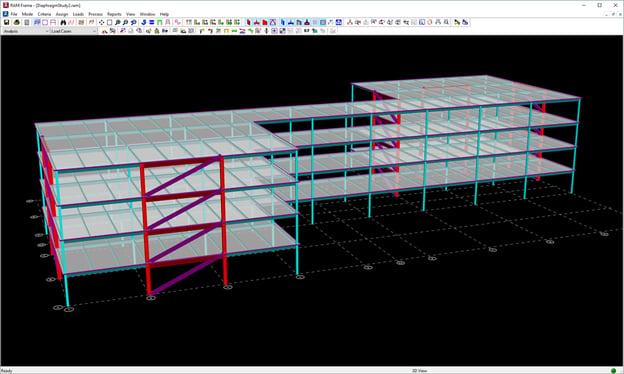In my last post, I discussed the modeling requirements for semirigid diaphragms. When modeling with a semirigid diaphragm, it is necessary to indicate the appropriate in-plane properties, including thickness, modulus of elasticity, and Poisson’s ratio; identify the extents of the diaphragm boundaries including significant slab openings; and mesh the diaphragm into a set of plate elements for the finite element analysis.
Coarse Mesh vs Fine Mesh Sizes
The question arises on the appropriate mesh size to use. What is the impact on the results if a coarse mesh is used versus a fine mesh?
The structure shown here was analyzed in Bentley Systems’ RAM Structural System. This example structure was selected because of the asymmetry of the frames and the narrow diaphragms through the center of the floor plan.
The structure was analyzed several times with semirigid diaphragms, using a range of mesh sizes from 1 ft to 15 ft. The figure below shows a comparison of the 1-foot mesh versus the 15-foot mesh. For comparison, the model was also analyzed with the diaphragms specified as Rigid.

For each analysis the story shear at each level in each frame was tabulated. The table below shows the story shears (kips) at each story of each of the three transverse frames, for each mesh size.

Using the 1-foot mesh as a baseline, the values shown in parentheses are the percent difference between frame story shears for that mesh size and the 1-foot mesh size. As you can see, for this model, the story shears generally only varied by a fraction of a percent between the finest mesh and the coarsest mesh. The size of the mesh used in the analysis had very little impact on the distribution of the lateral forces; the analysis was not sensitive to the mesh size. It is important to note that the rigid diaphragm analysis didn’t compare well, with the frame story shears in error by over 50% in some cases. This is a good indication that some structures should not be analyzed using the rigid diaphragm assumption.
An important consideration is the impact of mesh size on the analysis time. For this structure the analysis took 2 seconds for the model with the 15-foot mesh, but it took 5 minutes 41 seconds for the model with the 1-foot mesh. For larger, more complicated structures it may be more practical to use a bit coarser mesh, to reduce the analysis times. From this exercise, we can see that a small refined mesh isn’t necessary, and that a reasonably large mesh gives acceptably accurate results with the benefit of substantially faster analysis times.
In addition to the frame story force comparison discussed above, the results for several other structural responses were similarly tabulated and compared. Space doesn’t allow for an exhaustive presentation of those results here, but a few things are noteworthy. The impact of mesh size on the diaphragm shear across the narrow segment of diaphragm was considerably more pronounced: there was a 22% difference between the value given with the 15-foot mesh and that given with the 1-foot mesh. That difference dropped to 5% for the 8-foot mesh and was 1% for the 4-foot mesh. The story drift at the most critical end of the structure also was impacted, but to a lesser extent: there was a 6% difference between the value given with the 15-foot mesh and that given with the 1-foot mesh. That difference dropped to 3% for the 8-foot mesh and was 2% for the 4-foot mesh.
For practical reasons I recommend specifying a larger mesh, say 4 ft or even 8 ft. The accuracy is within a small few percent or even a fraction of a percent of a more refined mesh, but the analysis times are dramatically shorter. You will work more productively.
You need to recognize that this is just one small example, and the study was certainly not exhaustive. You should take advantage of the analytical tools that are now available to you to create your own models and do your own studies. You need to decide for yourself what you are comfortable with.





